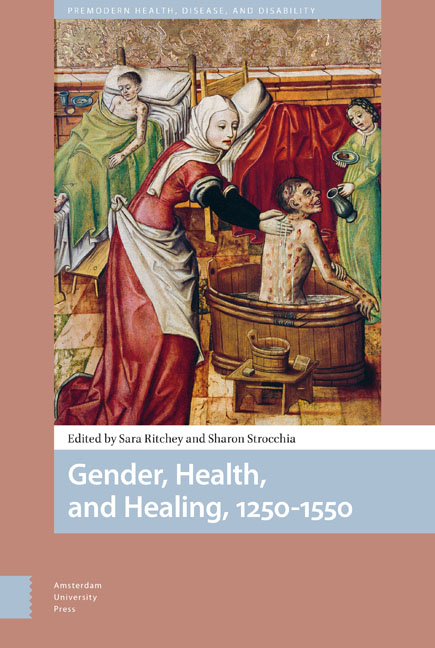Book contents
- Frontmatter
- Contents
- List of Figures and Tables
- Acknowledgments
- Abbreviations
- Introduction: Gendering Medieval Health and Healing: New Sources, New Perspectives
- Part 1 Sources of Religious Healing
- 1 Caring by the Hours: The Psalter as a Gendered Healthcare Technology
- 2 Female Saints as Agents of Female Healing: Gendered Practices and Patronage in the Cult of St. Cunigunde
- Part 2 Producing and Transmitting Medical Knowledge
- 3 Blood, Milk, and Breastbleeding: The Humoral Economy of Women's Bodies in Medieval Medicine
- 4 Care of the Breast in the Late Middle Ages: The Tractatus de passionibus mamillarum
- 5 Household Medicine for a Renaissance Court: Caterina Sforza's Ricettario Reconsidered
- 6 Understanding/Controlling the Female Body in Ten Recipes: Print and the Dissemination of Medical Knowledge about Women in the Early Sixteenth Century
- Part 3 Infirmity and Care
- 7 Ubi non est mulier, ingemiscit egens?: Gendered Perceptions of Care from the Thirteenth to Sixteenth Centuries
- 8 Domestic Care in the Sixteenth Century: Expectations, Experiences, and Practices from a Gendered Perspective
- 9 Bathtubs as a Healing Approach in Fifteenth-Century Ottoman Medicine
- Part 4 (In)fertility and Reproduction
- 10 Gender, Old Age, and the Infertile Body in Medieval Medicine
- 11 Gender Segregation and the Possibility of Arabo-Galenic Gynecological Practice in the Medieval Islamic World
- Afterword: Healing Women and Women Healers
- Contributors
- Index
Introduction: Gendering Medieval Health and Healing: New Sources, New Perspectives
Published online by Cambridge University Press: 23 June 2021
- Frontmatter
- Contents
- List of Figures and Tables
- Acknowledgments
- Abbreviations
- Introduction: Gendering Medieval Health and Healing: New Sources, New Perspectives
- Part 1 Sources of Religious Healing
- 1 Caring by the Hours: The Psalter as a Gendered Healthcare Technology
- 2 Female Saints as Agents of Female Healing: Gendered Practices and Patronage in the Cult of St. Cunigunde
- Part 2 Producing and Transmitting Medical Knowledge
- 3 Blood, Milk, and Breastbleeding: The Humoral Economy of Women's Bodies in Medieval Medicine
- 4 Care of the Breast in the Late Middle Ages: The Tractatus de passionibus mamillarum
- 5 Household Medicine for a Renaissance Court: Caterina Sforza's Ricettario Reconsidered
- 6 Understanding/Controlling the Female Body in Ten Recipes: Print and the Dissemination of Medical Knowledge about Women in the Early Sixteenth Century
- Part 3 Infirmity and Care
- 7 Ubi non est mulier, ingemiscit egens?: Gendered Perceptions of Care from the Thirteenth to Sixteenth Centuries
- 8 Domestic Care in the Sixteenth Century: Expectations, Experiences, and Practices from a Gendered Perspective
- 9 Bathtubs as a Healing Approach in Fifteenth-Century Ottoman Medicine
- Part 4 (In)fertility and Reproduction
- 10 Gender, Old Age, and the Infertile Body in Medieval Medicine
- 11 Gender Segregation and the Possibility of Arabo-Galenic Gynecological Practice in the Medieval Islamic World
- Afterword: Healing Women and Women Healers
- Contributors
- Index
Summary
The essays in Gender, Health, and Healing, 1250-1550 take as their point of departure an integrative, hybrid model of analysis that illuminates the intersections between healthcare and other aspects of medieval and Renaissance culture. Taking this integrative approach widens the lens from the narrow terrain of academic, text-based medicine to include common forms of health maintenance and curative practice such as bathing, prayer, the use of cosmetics and wellness products, and other methods of caring for the body and self. By situating a range of caregiving techniques within the more inclusive framework of ‘health and healing’, the essays place diverse strains of healthcare such as household medicine and spiritual-liturgical therapeutics on a continuum with academic medicine, and then show how these varied modes of healing interacted with and informed one another. The volume thus decentres theoretical medicine to make room for the lived experience of healthcare in all of its diversity at a formative moment in history. The period under examination here, ranging from the thirteenth to the sixteenth centuries, warrants particular scrutiny because it is commonly identified with the emergence of professional medicine as a distinct body of knowledge and practice. During these centuries, university-trained physicians sought to assert their superior professional competencies, in part by laying claim to theoretical principles that governed the natural world and human bodies, and to which their extensive education and institutional affiliation gave them unique access. The operation of gender shaped this process in fundamental ways by coding certain acts and identities as professional and others as informal or unskilled.
One of the most significant ways in which this volume achieves an integrative picture of late medieval and Renaissance healthcare is through the intentional expansion of the sources and methods that traditionally constitute medical history. The essays in this volume plumb a wide array of materials that run the gamut from the religious, domestic, and legal to the literary, homiletic, and visual. By taking a more capacious approach to sources beyond canonical texts, the volume showcases the sheer complexity of everyday caregiving and health maintenance in the late medieval and Renaissance period. Drawing on a broader palette of sources informs our understanding of how varieties of bodywork and caregiving were organized and practised on an aggregate social scale as well as in the more intimate realms of household and community.
- Type
- Chapter
- Information
- Gender, Health, and Healing, 1250–1550 , pp. 15 - 38Publisher: Amsterdam University PressPrint publication year: 2020

